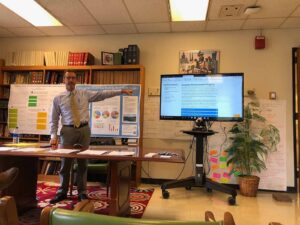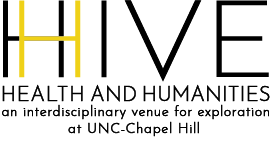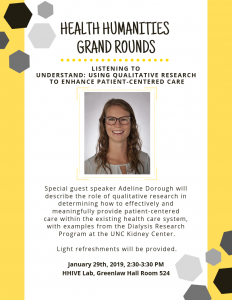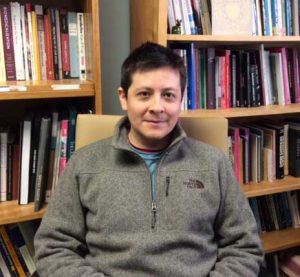2018-2019 HHGR
2018-2019 Speakers
Sept. 19, 2018, “Patient and Family Centered Maternity Care and Continuous Labor Support as Evidence-Based Practice” with Rhonda Lanning of the UNC School of Nursing
“While Professor Lanning believes the most important aspect of the doula program is its emotional support, she also provided data to reinforce the statistical importance of the program,” Kate Capitano writes for our blog. “The maternity crisis in the U.S. consists of the rising rate of maternal mortality, the disparity between outcomes of white mothers versus mothers of color, and elevated rates of postpartum depression in new mothers. According to the Cochrane Review of 2017, the continuous presence of an unrelated individual conclusively improves birth outcomes. Mothers have also been shown to remember how they were treated as a person more so than other aspects of their birth experience when asked about it decades after the birth.”
Oct. 14, 2018, “Advanced Practice Registered Nurse Education, Regulation, and Scope of Practice” with Tom Bush of the UNC School of Nursing
“As positive press about recent lows in unemployment circulate in the U.S., there is in fact one profession that exceeds all others in job availability and will continue to do so through the year 2022,” Kate Capitano writes for our blog. “According to Tom Bush, Assistant Dean of Practice and Associate Professor at the UNC School of Nursing, ‘There has never been a better time to be a nurse.’ Dr. Bush gave an inspiring talk at the HHIVE Lab that shed light on the plethora of opportunities available to those who major in nursing or get a graduate degree as he did. The nurse practitioner profession has been propelled by a shift in health care towards more interactive care brought on by the compassionate and charismatic individuals who populate the specialty.”
Nov. 7, 2018, “Engineering Patient Safety in Healthcare Settings” with Lukasz Mazur of the UNC School of Information Science, UNC School of Public Health, and the UNC School of Medicine (Radiation Oncology)
The recent adoption of health information technology (health-IT) has been a mixed blessing for patient safety. Indeed, human errors during interactions with health-IT have become one of the top patient safety concerns. Therefore, in this talk, I will overview promising prototypes to ‘optimize’ cognitive workload and performance during providers’ interactions with health-IT. Specifically, I will use examples from Radiation therapy (RT) which is used to treat ≈ 50% of patients with cancer, and errors in planning/delivery are estimated to occur in ≈ 5% of the > ≈600,000 patients receiving radiation therapy per year in the US. RT has been highly dependent on health-IT for decades, with essentially all of our critical clinical and QA tasks being done in an electronic environment. Thus, the lessons from this talk will be also generalizable to other areas of medicine and beyond that are also becoming more reliant on health-IT.
Jan. 29, 2019, “Listening to Understand: Using Qualitative Research to Enhance Patient-Centered Care” with Adeline Dorough of the UNC Kidney Center and the UNC School of Public Health
Describe the role of qualitative research in determining how to effectively and meaningfully provide patient-centered care within the existing health care system; provide examples from the Dialysis Research Program at the UNC Kidney Center.
Feb. 19, 2019, “Cancer Care Global Histories and the Education of Health Workers” with Raul Necochea of the UNC School of Medicine’s Department of Social Medicine
In a nutshell, throughout the 20th century, cervical cancer was the most lethal, common, and preventable of cancers in the region. Nowadays, cervical cancer is considered linked to a sexually-transmitted microbe, the human papilloma virus. Knowledge about HPV has transformed our understanding of the etiology and epidemiology of cancer, and even resulted in vaccines to prevent HPV infection. But to what extent do older institutions, attitudes, and technologies that long defined our approach to such a deadly disease still shape contemporary cancer care globally? As a faculty member in a medical school, I believe the humanistic and social scientific orientation that animates this research can further the integral education of health workers in three ways: (1) by producing interventions within spaces that already exist in the medical curriculum for the appreciation and contextualization of primary historical sources; (2) by emphasizing care in diverse circumstances as a crucial value health professionals must learn to understand, deploy, and defend; and (3) by calling attention to the emergence and development of interprofessional teamwork in health care settings. I propose to discuss the blueprint of this evolving project and would appreciate feedback about pitfalls/opportunities about implementing it.
April 2, 2019, “All the New Information in My Blood: Immunity, Melancholy, Virality” with Travis Alexander, PhD Candidate in UNC’s Department of English and Comparative Literature
This talk expands on the psychoanalytic work of Nicholas Abraham and Maria Torok to posit that the arrival of HIV didn’t simply constitute a neutralization of the immunological fetishism of the postwar period. Rather, the loss
of immunity—a trauma that could not speak its name—precipitates what we might term a biopolitical melancholia. Having lost access to its privileged topos—the immune system itself—immunological governance in turn proximately gravitates toward the object responsible for its trauma: namely, HIV. I propose thus to read Neal Stephenson’s cyberpunk satire Snow Crash (1992) as staging the embrace of virality. In Stephenson’s narrative, virality emerges ironically as the most viable vehicle for conserving the fantasies of both neoliberal competency and racial containment modeled initially by immunity itself.






